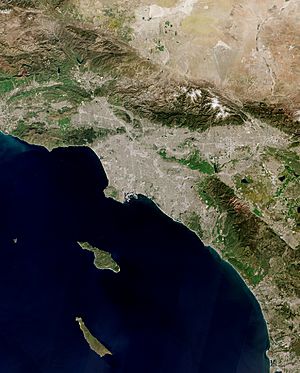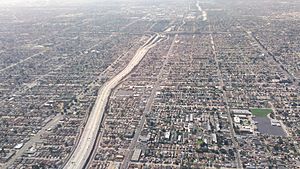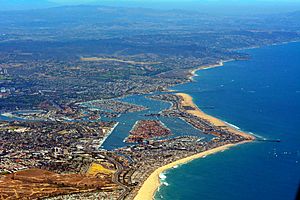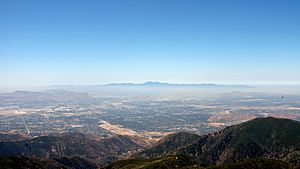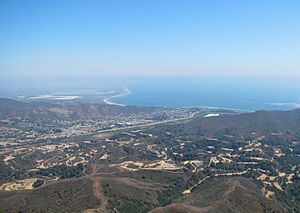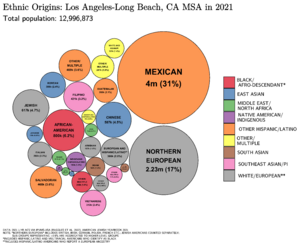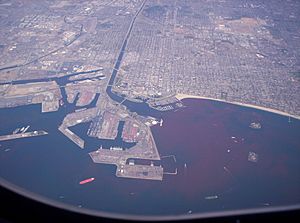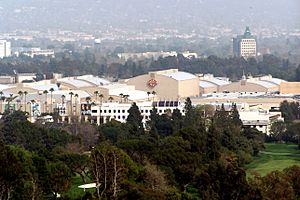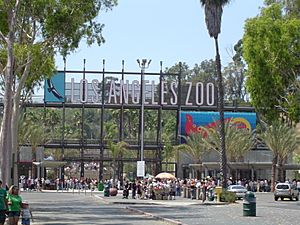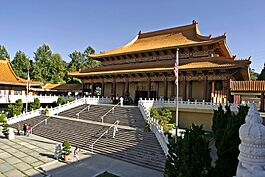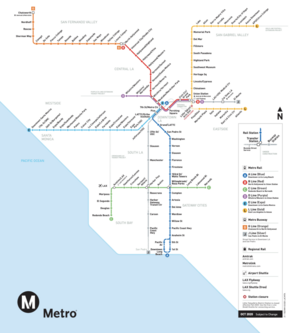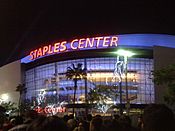Greater Los Angeles facts for kids
Quick facts for kids
Greater Los Angeles
Los Angeles–Long Beach, CA CSA
|
|
|---|---|
|
Megacity and combined statistical area
|
|

Urban areas
Counties in the Los Angeles MSA Counties in the Los Angeles CSA but not the MSA |
|
| Country | United States |
| State | California |
| Principal city | Los Angeles |
| Other major cities |
|
| Area | |
| • Urban | 2,281.0 sq mi (5,907.8 km2) |
| • Metro | 33,954 sq mi (87,940 km2) |
| Highest elevation | 11,503 ft (3,507 m) |
| Lowest elevation | 0 ft (0 m) |
| Population
(2023)
|
|
| • Megacity and combined statistical area | 18,422,600 |
| • Density | 541.1/sq mi (208.9/km2) |
| Ranked 2nd in the US | |
| GDP | |
| • Megacity and combined statistical area | $1.528 trillion (2022) |
| Time zone | UTC−8 (PST) |
| • Summer (DST) | UTC−7 (PDT) |
| Area codes | 213/323, 310/424, 562, 626, 661, 714/657, 760/442, 805/820, 818/747, 909/840, 949, 951 |
|
Los Angeles Metropolitan Area
|
|
|---|---|
| Los Angeles–Long Beach–Anaheim, CA MSA | |
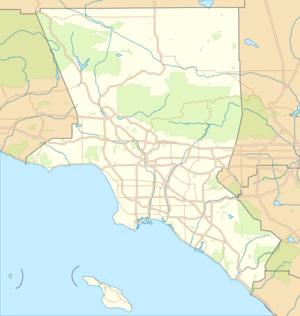 |
|
| Country | United States |
| State(s) | California |
| Largest city | Los Angeles |
| Area | |
| • Total | 4,850.3 sq mi (12,562 km2) |
| Highest elevation | Mount San Antonio 10,064 ft (3,069 m) |
| Lowest elevation | Wilmington −9 ft (-3 m) |
| Population
(2023)
|
|
| • Total | 12,872,322 |
| • Rank | 2nd in the U.S. |
| • Density | 2,654/sq mi (1,025/km2) |
| GDP | |
| • Total | $1.227 trillion (2022) |
| Time zone | UTC–8 (Pacific) |
| • Summer (DST) | UTC–7 (PDT) |

Greater Los Angeles is a huge area in Southern California. It includes five counties: Ventura County, Los Angeles County, Orange County, San Bernardino County, and Riverside County. It's like a giant city made up of many smaller cities and towns.
This area is one of the biggest in the United States. It covers about 33,954 square miles (87,940 square kilometers). Most of this land is mountains and deserts, but the cities themselves cover a large area. In 2024, about 18.4 million people lived here, making it the second-largest metropolitan area in the country. Only New York is bigger.
Greater Los Angeles is famous for its movies, TV shows, and music. It's also a major center for global trade, education, technology, and tourism. Its economy is one of the largest in the world, worth over $1 trillion!
The area has three main parts. The Inland Empire includes Riverside and San Bernardino counties. Ventura County is its own area. Then there's the Los Angeles metropolitan area, which includes Los Angeles and Orange counties. This part alone has about 13 million people. Even though San Diego–Tijuana is close, it's not part of Greater Los Angeles because there's a military base, Camp Pendleton, that separates them.
For a long time, Greater Los Angeles grew very fast. But since 2000, its growth has slowed down.
Contents
Understanding Greater Los Angeles
When we talk about "Greater Los Angeles," we're talking about a very large region. Experts use different ways to define it, like how many people live there or how far people travel for work.
| Area (km2) | Population (2024) | GDP (million US$) |
|
|---|---|---|---|
| Los Angeles–Long Beach–Anaheim, CA (MSA) | 12,580 | 12,974,926 | 1,227,469 |
| Riverside–San Bernardino–Ontario, CA (MSA) | 70,610 | 4,623,811 | 237,913 |
| Oxnard–Thousand Oaks–Ventura, CA (MSA) | 4,770 | 823,863 | 62,239 |
| Los Angeles–Long Beach, CA CSA | 87,960 | 18,422,600 | 1,527,621 |
What is the Los Angeles Metropolitan Area?
The U.S. government calls the Los Angeles metropolitan area the Los Angeles–Long Beach–Anaheim, CA Metropolitan Statistical Area (MSA). In 2021, about 13 million people lived here. This MSA is divided into two parts:
- The Los Angeles–Long Beach–Glendale area, which is the same as Los Angeles County.
- The Anaheim–Santa Ana–Irvine area, which is the same as Orange County.
This MSA is the second most populated metropolitan area in the United States. Its main urban area, Los Angeles–Long Beach–Anaheim, had over 12 million people in 2020.
What is Greater Los Angeles?
The U.S. Census Bureau also defines a larger area called the Los Angeles–Long Beach, CA Combined Statistical Area (CSA). This is what people usually mean by Greater Los Angeles. It includes the MSA plus other nearby areas where people commute for work. In 2024, about 18.4 million people lived in this larger area.
The CSA is made up of three main metropolitan areas:
- The Los Angeles–Long Beach–Anaheim, CA MSA (Los Angeles and Orange counties).
- The Oxnard–Thousand Oaks–Ventura, CA MSA (all of Ventura County).
- The Riverside–San Bernardino–Ontario, CA MSA (all of Riverside County, California and San Bernardino County, California).
History of the Region
Long ago, almost all of the Greater Los Angeles area was the homeland of the Tongva people, also known as Tovaangar. Their history is an important part of this region.
Geography and City Layout
Los Angeles is known for being very spread out. This is because it grew a lot when cars became popular. People could live further from work and still get around. It was one of the first big American cities where jobs and shopping centers were built outside the main downtown area. This meant that Los Angeles didn't have just one central hub, but many different important areas spread out.
Even though Los Angeles city itself isn't super dense everywhere, many of its suburbs and nearby cities are very crowded. Buildings are often low-rise due to city rules. The area used to have a network of electric streetcars, which helped spread people out to smaller towns. Later, cars helped fill in the spaces between these towns.
In the 1960s and 70s, many people moved to the San Fernando Valley and Conejo Valley in Ventura County. This was because freeways made it easier to travel to Los Angeles for work. Even though there's still a lot of open space, much of it is protected from development. This has made housing prices go up a lot.
The Los Angeles area is still growing, especially in areas further out where land is cheaper. Riverside and San Bernardino Counties saw a lot of growth between 2000 and 2006. New buildings and renovations are also happening in downtown areas. However, droughts and wildfires have become more common, making water supply a big concern for future development.
Major Business Areas
Greater Los Angeles has many important business districts. The biggest is Downtown Los Angeles. Other key downtowns include Downtown Long Beach, downtown Pasadena, downtown Glendale, and downtown Burbank.
However, most of the business activity, like offices, shops, and entertainment, is found in areas outside these traditional downtowns. These are called "edge cities." Los Angeles was one of the first big cities to develop this way, starting in the 1920s. This means that important businesses and cultural spots are spread out, not just in one central place.
Regional Identity
People in Greater Los Angeles sometimes feel more connected to their local area than to the whole region. For example, people in Orange County often see themselves as different from those in Los Angeles County, even though they are part of the same metropolitan area. This is because different parts of the region have their own unique cultures and economies.
Counties and Cities in Greater Los Angeles

Los Angeles County
Los Angeles County is the most populated county in the United States. The city of Los Angeles is its main city. Because Los Angeles is so big and has added many smaller towns over time, the city borders can be confusing. Many cities are completely surrounded by Los Angeles but are still independent.
Most of the land in Los Angeles County is undeveloped, especially in mountain and desert areas. New developments often happen on the edges of existing cities, like Palmdale and Lancaster.
Areas in Los Angeles County
The Los Angeles Times divides Los Angeles County into several regions:
- Antelope Valley
- Central L.A. (Downtown Los Angeles, Hollywood)
- Eastside
- San Fernando Valley
- San Gabriel Valley
- South Bay
- Westside
These areas are often separated by natural features like mountains or the ocean, or by freeways and city lines.
Cities in Los Angeles County
The City of Los Angeles is the second most populated city in the U.S., with almost 3.9 million people in 2020. It's a global center for finance, entertainment, and culture.
Here are some of the largest cities in Los Angeles County (2020 population):
- Los Angeles (3,898,747)
- Long Beach (466,742)
- Santa Clarita (228,673)
- Glendale (196,543)
- Lancaster (173,516)
- Palmdale (169,450)
- Pomona (151,713)
- Torrance (147,067)
- Pasadena (138,699)
- East Los Angeles CDP (118,786)
- Downey (114,355)
- West Covina (109,501)
- El Monte (109,450)
- Inglewood (107,762)
- Burbank (107,337)
- Norwalk (102,773)
Orange County
Orange County used to be mostly farms. It became a place where people lived and commuted to Los Angeles after the Santa Ana Freeway was built in the 1950s. By the 1970s, it grew its own economy with tourism and electronics.
Today, Orange County is known for places like Disneyland, Knott's Berry Farm, and its beautiful beaches. It also has wealthy areas. There isn't one main downtown, but important business areas exist in Downtown Santa Ana and other "edge cities" like those around Disneyland and Irvine.
Orange County is sometimes split into "North County" and "South County." North Orange County is older, more diverse, and closer to Los Angeles. South County is newer, more residential, and generally wealthier.
Cities in Orange County
Here are some of the largest cities in Orange County (2020 population):
- Anaheim (346,824)
- Santa Ana (310,227)
- Irvine (307,670)
- Huntington Beach (198,711)
- Garden Grove (171,949)
- Fullerton (143,617)
- Orange (139,911)
- Costa Mesa (111,918)
- Mission Viejo (93,653)
- Westminster (90,911)
Inland Empire
The Inland Empire includes San Bernardino County and Riverside County. Many people who live here travel to Los Angeles or Orange Counties for work. This area used to be known for growing citrus fruits. Later, it became an important industrial area and a key transportation hub because of major highways like Interstate 10.
After World War II, as Los Angeles and Orange Counties grew, developers built many new suburbs in the Inland Empire. This helped house the growing population of the Los Angeles area. The Inland Empire is also a major center for warehouses, shipping, and retail businesses, especially in cities like Riverside, San Bernardino, and Ontario.
While the Inland Empire includes all of San Bernardino and Riverside Counties, the eastern desert parts are not considered part of Greater Los Angeles. However, because of the huge freeway system, these areas are becoming more connected to the main urban areas.
Cities in Riverside County
Here are some of the largest cities in Riverside County (2020 population):
- Riverside (314,998)
- Moreno Valley (208,634)
- Corona (157,136)
- Murrieta (110,949)
- Temecula (110,003)
- Jurupa Valley (105,053)
- Menifee (102,527)
- Hemet (89,833)
- Indio (89,137)
- Perris (78,700)
Cities in San Bernardino County
Here are some of the largest cities in San Bernardino County (2020 population):
- San Bernardino (222,101)
- Fontana (208,393)
- Ontario (175,265)
- Rancho Cucamonga (174,453)
- Victorville (134,810)
- Rialto (104,026)
- Hesperia (99,818)
- Chino (91,403)
- Upland (79,040)
- Chino Hills (78,411)
Ventura County
Ventura County is mostly suburban and rural. It also grew a lot because of Los Angeles's expansion. Small towns along the coast grew as people from the San Fernando Valley moved there. Many planned communities were built, and the county became more urban. The northern part of the county is still mostly undeveloped and includes parts of the Los Padres National Forest.
Cities in Ventura County
Here are the cities in Ventura County (2020 population):
- Oxnard (202,063)
- Thousand Oaks (126,966)
- Simi Valley (126,356)
- Ventura (110,763)
- Camarillo (70,741)
- Moorpark (36,284)
- Santa Paula (30,657)
- Port Hueneme (21,954)
- Fillmore (16,419)
- Ojai (7,637)
Urban Areas within Greater Los Angeles
The main urban area in Greater Los Angeles is Los Angeles–Long Beach–Anaheim. It's the second most populated urban area in the U.S. The Census Bureau also identifies 30 other urban areas within Greater Los Angeles.
| Urban area | Population (2020 census) |
Land area (sq mi) |
Land area (km2) |
Density (population / sq mi) |
Density (population / km2) |
|---|---|---|---|---|---|
| Los Angeles–Long Beach–Anaheim, CA | 12,237,376 | 1,636.83 | 4,239.36 | 7,476.28 | 2,886.61 |
| Riverside–San Bernardino, CA † | 2,276,703 | 608.56 | 1,576.17 | 3,741.10 | 1,444.45 |
| Mission Viejo–Lake Forest–Laguna Niguel, CA | 646,843 | 163.63 | 423.81 | 3,953.02 | 1,526.27 |
| Temecula–Murrieta–Menifee, CA † | 528,991 | 150.47 | 389.73 | 3,515.49 | 1,357.34 |
| Oxnard–San Buenaventura (Ventura), CA † | 376,117 | 76.61 | 198.41 | 4,909.70 | 1,895.65 |
| Indio–Palm Desert–Palm Springs, CA † | 361,075 | 151.82 | 393.22 | 2,378.26 | 918.25 |
| Palmdale–Lancaster, CA | 359,559 | 84.78 | 219.59 | 4,240.90 | 1,637.42 |
| Victorville–Hesperia–Apple Valley, CA † | 355,816 | 131.77 | 341.29 | 2,700.19 | 1,042.55 |
| Santa Clarita, CA | 278,031 | 77.85 | 201.62 | 3,571.56 | 1,378.99 |
| Thousand Oaks, CA † | 213,986 | 80.20 | 207.71 | 2,668.26 | 1,030.22 |
| Hemet, CA † | 173,194 | 37.06 | 95.98 | 4,673.61 | 1,804.49 |
| Simi Valley, CA † | 127,364 | 31.63 | 81.91 | 4,027.01 | 1,554.84 |
| Camarillo, CA † | 76,338 | 22.48 | 58.22 | 3,395.98 | 1,311.19 |
| Desert Hot Springs, CA † | 45,767 | 14.08 | 36.47 | 3,250.66 | 1,255.09 |
| Santa Paula, CA † | 30,675 | 4.96 | 12.86 | 6,179.04 | 2,385.74 |
| Barstow, CA † | 30,522 | 12.38 | 32.07 | 2,465.05 | 951.76 |
| Crestline–Lake Arrowhead, CA † | 22,272 | 16.85 | 43.64 | 1,321.70 | 510.31 |
| Yucca Valley, CA † | 18,293 | 11.33 | 29.36 | 1,613.95 | 623.15 |
| Big Bear, CA † | 16,498 | 15.93 | 41.26 | 1,035.73 | 399.90 |
| Fillmore, CA † | 16,397 | 2.63 | 6.82 | 6,227.80 | 2,404.57 |
| Twentynine Palms, CA † | 12,881 | 6.82 | 17.66 | 1,889.13 | 729.40 |
| Blythe, CA–AZ † | 11,780 | 6.20 | 16.06 | 1,899.83 | 733.53 |
| Twentynine Palms North, CA † | 11,665 | 2.77 | 7.18 | 4,206.03 | 1,623.96 |
| Fort Irwin, CA † | 8,096 | 3.62 | 9.37 | 2,238.42 | 864.26 |
| Mecca, CA † | 6,875 | 0.63 | 1.62 | 10,979.30 | 4,239.13 |
| Needles, CA–AZ † | 6,739 | 5.55 | 14.38 | 1,213.99 | 468.73 |
| Silver Lakes, CA † | 5,908 | 2.12 | 5.49 | 2,789.52 | 1,077.04 |
| Running Springs, CA † | 5,313 | 3.64 | 9.44 | 1,458.40 | 563.09 |
| Joshua Tree, CA † | 4,370 | 3.80 | 9.85 | 1,149.11 | 443.67 |
| Wrightwood, CA † | 3,927 | 1.38 | 3.59 | 2,835.51 | 1,094.80 |
| Avalon, CA | 3,362 | 1.19 | 3.08 | 2,826.47 | 1,091.31 |
Population and People
| Historical population Greater Los Angeles CSA (Five-county area) |
|||
|---|---|---|---|
| Census | Pop. | %± | |
| 1900 | 250,187 | — | |
| 1910 | 648,316 | 159.1% | |
| 1920 | 1,150,252 | 77.4% | |
| 1930 | 2,597,066 | 125.8% | |
| 1940 | 3,252,720 | 25.2% | |
| 1950 | 4,934,246 | 51.7% | |
| 1960 | 7,751,616 | 57.1% | |
| 1970 | 9,981,942 | 28.8% | |
| 1980 | 11,497,486 | 15.2% | |
| 1990 | 14,531,529 | 26.4% | |
| 2000 | 16,373,645 | 12.7% | |
| 2010 | 17,877,006 | 9.2% | |
| 2020 | 18,644,680 | 4.3% | |
| 2023 (est.) | 18,422,600 | 3.1% | |
| U.S. Census Bureau | |||
In 2020, over 18.6 million people lived in the Greater Los Angeles Area. The population is very diverse. About 29.4% of people were White (not Hispanic), and 13.8% were Asian (not Hispanic). About 6.1% were African American (not Hispanic).
The biggest group is Hispanic or Latino, making up 46.3% of the population. Most of them are of Mexican background. Many people here were born in other countries, mostly from Latin America and Asia.
The area grew very fast in the 20th century. This was because of its nice weather and many growing industries like movies, cars, and aerospace. These industries brought millions of people from all over the U.S. and the world.
Population in Los Angeles and Orange Counties
| County | 2021 Estimate | 2020 Census | Change | Area | Density |
|---|---|---|---|---|---|
| Los Angeles County | 9,829,544 | 10,014,009 | −1.84% | 4,057.88 sq mi (10,509.9 km2) | 2,422/sq mi (935/km2) |
| Orange County | 3,167,809 | 3,186,989 | −0.60% | 790.57 sq mi (2,047.6 km2) | 4,007/sq mi (1,547/km2) |
| Total | 12,997,353 | 13,200,998 | −1.54% | 4,848.45 sq mi (12,557.4 km2) | 2,681/sq mi (1,035/km2) |
| Historical population Los Angeles MSA (Los Angeles and Orange Counties) |
|||
|---|---|---|---|
| Census | Pop. | %± | |
| 1890 | 115,043 | — | |
| 1900 | 189,994 | 65.2% | |
| 1910 | 538,567 | 183.5% | |
| 1920 | 997,830 | 85.3% | |
| 1930 | 2,327,166 | 133.2% | |
| 1940 | 2,916,403 | 25.3% | |
| 1950 | 4,367,911 | 49.8% | |
| 1960 | 6,742,696 | 54.4% | |
| 1970 | 8,462,366 | 25.5% | |
| 1980 | 9,410,130 | 11.2% | |
| 1990 | 11,273,720 | 19.8% | |
| 2000 | 12,365,627 | 9.7% | |
| 2010 | 12,828,837 | 3.7% | |
| 2020 | 13,200,998 | 2.9% | |
| 2023 (est.) | 12,799,100 | −0.2% | |
| State Census data | |||
Age and Gender
| Age distribution Los Angeles and Orange Counties, 2009 |
|
|---|---|
| Age | % of pop. |
| Under 5 | 7.3% |
| 5 to 9 | 6.6% |
| 10 to 14 | 7.0% |
| 15 to 19 | 7.2% |
| 20 to 24 | 7.0% |
| 25 to 34 | 15.5% |
| 35 to 44 | 14.8% |
| 45 to 54 | 13.9% |
| 55 to 59 | 5.5% |
| 60 to 64 | 4.4% |
| 65 to 74 | 5.6% |
| 75 to 84 | 3.6% |
| 85 and over | 1.6% |
| Median age | 34.6 |
In 2009, the Los Angeles Metropolitan Area had about 12.8 million people. The population was almost evenly split between males (49.7%) and females (50.3%). The median age was 34.6 years old.
Different Backgrounds
The Greater Los Angeles Area is a melting pot of cultures. Many people from different parts of the world call it home.
- White (not Hispanic): About 29.4% of the population. Many have German, English, or Irish roots.
- Asian (not Hispanic): About 13.8% of the population. The largest groups are Chinese, Filipino, Vietnamese, and Korean.
- African American (not Hispanic): About 6.1% of the population.
- Hispanic or Latino: This is the largest group, making up 46.3% of the population. Most are of Mexican descent, but there are also many Salvadoran, Guatemalan, and other Central and South American groups.
Economy and Jobs
The Los Angeles area has one of the largest economies in the world. In 2022, the economy of Greater Los Angeles was worth over $1.5 trillion!
The economy here is famous for the entertainment industry, especially movies, TV, and music. Hollywood is known as the "movie capital of the United States."
Other important industries include:
- Shipping and Trade: The Port of Los Angeles and Port of Long Beach are two of the busiest seaports in the U.S. They handle a lot of goods coming in and out of the country.
- Logistics: The Inland Empire has many warehouses and shipping facilities.
- Aerospace and Technology: Companies that make airplanes and space equipment, and tech companies, are important here.
- Tourism: Millions of people visit the area each year.
- Automobiles: Many Asian car companies, like Mitsubishi and Honda, have their U.S. headquarters here.
Many big companies have their main offices in Los Angeles, including energy companies, healthcare providers, and entertainment giants like The Walt Disney Company in Burbank.
Economic Facts for Los Angeles and Orange Counties
In 2014, the Los Angeles–Long Beach–Anaheim metropolitan area had about 13.2 million people. The average income per person was about $50,751.
The area is a big exporter, sending out $75.5 billion worth of goods in 2014. These exports included electronics, transportation equipment, and chemicals.
The top job sectors in the area include:
- Healthcare and social assistance (15.54%)
- Retail trade (11.27%)
- Hotels and food services (10.79%)
- Manufacturing (10.47%)
Utilities and Services
Greater Los Angeles has many companies that provide electricity, natural gas, cable TV, and internet services.
Electricity Providers
- Southern California Edison (serves most of the area)
- Los Angeles Department of Water and Power (serves Los Angeles city)
- Other local city power companies (Burbank, Glendale, Pasadena, Anaheim, Azusa, Vernon)
- San Diego Gas & Electric (serves southern Orange County)
The Palo Verde Nuclear Generating Station in Arizona helps provide electricity to the area.
Natural Gas Providers
- Southern California Gas Company (serves most of the area)
- City of Long Beach Gas Company
- San Diego Gas & Electric (serves southern Orange County)
Other Services
- Cable Television: Charter Spectrum and Cox Communications are major providers.
- Phone and Internet: Companies like AT&T, T-Mobile, Verizon, Frontier Communications, and Charter Spectrum provide these services.
Medical Care
The Los Angeles area has many hospitals and clinics. Major healthcare providers include Kaiser Permanente, Cedars-Sinai Health System, UCLA Health, and Providence Healthcare.
Events and Festivals
Greater Los Angeles hosts many exciting events throughout the year.
Major Events
- 626 Night Market (food and culture)
- Rose Parade (famous New Year's Day parade)
- LA Auto Show
- Holidays at the Disneyland Resort
- Newport Beach Christmas boat parade
- Palm Springs International Film Festival
- Vans U.S. Open of Surfing
Awards Ceremonies
Many famous awards shows happen here:
- Academy Awards (Oscars)
- Primetime Emmy Awards (TV)
- Golden Globes (film and TV)
- Grammy Awards (music)
- Screen Actors Guild Awards (acting)
Annual Fairs
- Los Angeles County Fair in Pomona
- Orange County Fair in Costa Mesa
- Riverside County Fair and Date Festival
Annual Conventions
Many large conventions take place here, bringing together fans and professionals:
- Anime Expo
- BlizzCon (video games)
- Electronic Entertainment Expo (E3 - video games)
- L.A. Comic Con
- NAMM Show (music products)
- VidCon (online video creators)
Fun Things to Do
Greater Los Angeles is a top tourist spot with tons of attractions!
Amusement Parks

- Disneyland and Disney California Adventure
- Knott's Berry Farm
- Six Flags Magic Mountain
- Universal Studios Hollywood
- Pacific Park (on Santa Monica Pier)
- Castle Park
Beaches
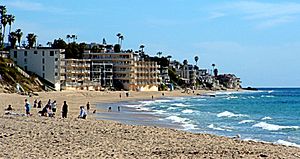
The coastline offers many beautiful beaches:
- Huntington Beach (Surf City USA)
- Laguna Beach (known for art and coves)
- Santa Monica and Venice Beach (famous piers and boardwalks)
- Long Beach
- Malibu
- Newport Beach
- San Clemente
Shopping Centers
You can find hundreds of places to shop, from fancy stores to unique boutiques.
- Rodeo Drive in Beverly Hills (luxury shopping)
- The Grove at Farmer's Market (outdoor mall with entertainment)
- South Coast Plaza in Costa Mesa (high-end shopping)
- Third Street Promenade in Santa Monica (pedestrian-only street)
- Universal CityWalk (shopping and dining near Universal Studios)
- Ontario Mills (outlet mall)
Film and TV Studio Tours
See where movies and TV shows are made!
- Universal Studios
- Warner Bros. Studios
- Paramount Studios
- Sony Pictures Studios
- Walt Disney Studios
Water Parks
Cool off at these fun water parks:
Zoos and Aquariums
- Los Angeles Zoo
- Aquarium of the Pacific in Long Beach
- Orange County Zoo
- Santa Ana Zoo
Museums
There are over 100 museums in the area, covering everything from art to science.
- Getty Center and Getty Villa (art and ancient artifacts)
- Griffith Observatory (science and space, great views)
- California Science Center (home of the Space Shuttle Endeavour)
- La Brea Tar Pits and Page Museum (ice age fossils)
- Los Angeles County Museum of Art (LACMA)
- Academy Museum of Motion Pictures (movie history)
- Natural History Museum of Los Angeles County
- Huntington Library (gardens, art, and books)
- Ronald Reagan Presidential Library
Other Fun Places
- Disneyland (of course!)
- Hollywood Walk of Fame and Hollywood Sign
- Santa Monica Pier (rides and games over the ocean)
- Catalina Island (a beautiful island getaway)
- Big Bear Lake (for skiing and lake activities)
- Joshua Tree National Park (unique desert landscapes)
- Palm Springs Aerial Tramway (rides up a mountain for amazing views)
- Watts Towers (unique art structures)
- The Mission Inn (historic hotel)
Transportation

Greater Los Angeles has a huge transportation system. It's known for its many freeways.
Highways
Major interstate highways connect the area:
 Interstate 5 (Golden State Freeway/Santa Ana Freeway/San Diego Freeway)
Interstate 5 (Golden State Freeway/Santa Ana Freeway/San Diego Freeway) Interstate 10 (Santa Monica Freeway/San Bernardino Freeway)
Interstate 10 (Santa Monica Freeway/San Bernardino Freeway) Interstate 15 (Escondido Freeway/Mojave Freeway)
Interstate 15 (Escondido Freeway/Mojave Freeway) Interstate 405 (San Diego Freeway)
Interstate 405 (San Diego Freeway)
Airports
- Los Angeles International Airport (LAX) is the main airport. It's one of the busiest in the world.
- Other airports include John Wayne Airport (SNA), Ontario International Airport (ONT), Hollywood Burbank Airport (BUR), and Long Beach Municipal Airport (LGB).
Public Transportation
- Metro Rail: Los Angeles County has a subway and light rail system called Los Angeles Metro Rail. It has six lines that connect many parts of the county.
- Metrolink: This is a commuter train system that connects Los Angeles with other cities in Southern California, including all five counties in Greater Los Angeles.
- Buses: Many bus systems operate throughout the region, like the Orange County Transportation Authority and Riverside Transit Agency.
Sports Teams
Los Angeles is a huge sports city! It has won more national championships across all sports than any other city in the U.S. It has also hosted the Summer Olympics twice (1932 and 1984) and will host them again in 2028.
Professional Sports Teams
| Team | Sport | League | Venue |
|---|---|---|---|
| Los Angeles Rams | American football | National Football League | SoFi Stadium |
| Los Angeles Chargers | |||
| Los Angeles Dodgers | Baseball | Major League Baseball | Dodger Stadium |
| Los Angeles Angels | Angel Stadium | ||
| Los Angeles Clippers | Basketball | National Basketball Association | Intuit Dome |
| Los Angeles Lakers | Crypto.com Arena | ||
| Los Angeles Sparks | Women's National Basketball Association | ||
| Los Angeles Kings | Ice hockey | National Hockey League | |
| Anaheim Ducks | Honda Center | ||
| LA Galaxy | Soccer | Major League Soccer | Dignity Health Sports Park |
| Los Angeles FC | BMO Stadium | ||
| Angel City FC | National Women's Soccer League |
College Sports

Many universities in the area have exciting college sports teams, especially in NCAA Division I. The rivalry between the UCLA Bruins and USC Trojans is very famous, as their campuses are only 12 miles apart!
See also
 In Spanish: Gran Los Ángeles para niños
In Spanish: Gran Los Ángeles para niños







